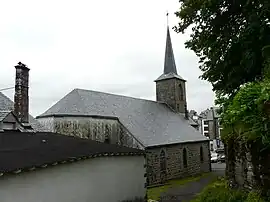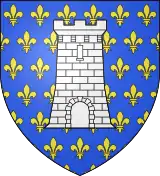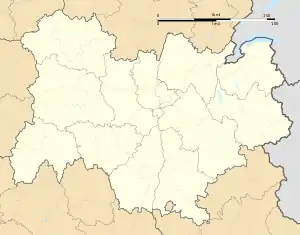La Tour-d'Auvergne
| |
|---|---|
 The Saint-Louis church in La Tour-d'Auvergne | |
 Coat of arms | |
Location of La Tour-d'Auvergne | |
 La Tour-d'Auvergne  La Tour-d'Auvergne | |
| Coordinates: 45°32′N 2°41′E / 45.53°N 2.69°E | |
| Country | France |
| Region | Auvergne-Rhône-Alpes |
| Department | Puy-de-Dôme |
| Arrondissement | Issoire |
| Canton | Le Sancy |
| Intercommunality | Dômes Sancy Artense |
| Government | |
| • Mayor (2020–2026) | Yannick Tournadre[1] |
| Area 1 | 48.29 km2 (18.64 sq mi) |
| Population | 626 |
| • Density | 13/km2 (34/sq mi) |
| Time zone | UTC+01:00 (CET) |
| • Summer (DST) | UTC+02:00 (CEST) |
| INSEE/Postal code | 63192 /63680 |
| Elevation | 719–1,691 m (2,359–5,548 ft) (avg. 1,000 m or 3,300 ft) |
| 1 French Land Register data, which excludes lakes, ponds, glaciers > 1 km2 (0.386 sq mi or 247 acres) and river estuaries. | |
La Tour-d'Auvergne (French pronunciation: [la tuʁ dovɛʁɲ], before 1961: Latour, Occitan: La Tor d'Auvèrnhe) is a commune in the Puy-de-Dôme department in Auvergne in central France.[3]
Geography
The commune of La Tour-d'Auvergne is located on the west slope of the Massif du Sancy, at the southwestern extremity of the Puy-de-Dôme departement. It is 60 km (37 miles) away from Clermont-Ferrand and is crossed by the départementale 203 linking the A89 motorway and the départementale 2089 to Besse-et-Saint-Anastaise and Issoire. La Tour-d'Auvergne was the chef-lieu of the canton until 2015, and was composed of eight communes (La Tour-d'Auvergne, Bagnols, Puy-de-Dôme, Cros, Puy-de-Dôme, Trémouille-Saint-Loup, Chastreix, Saint-Donat, Picherande and Saint-Genès-Champespe). On the Artense plateau, which extends itself in between Cantal and the Tarentaine river south, the dam retention of Bort-les-Orgues, the Corrèze and the Avèse gorges west, La Bourboule and Mont-Dore glacier valley north and the massif du Sancy east, La Tour-d'Auvergne is an ancient village which holds its foundations on a basaltic piton, an old vestige of a volcanic flow of the massif du Sancy when it was a volcano, more than 250 000 years ago. Standing on a natural promontory, the village is located in between the Burande valleys and its tributary, the Burandou.
See also
References
- ↑ "Répertoire national des élus: les maires" (in French). data.gouv.fr, Plateforme ouverte des données publiques françaises. 4 May 2022.
- ↑ "Populations légales 2021". The National Institute of Statistics and Economic Studies. 28 December 2023.
- ↑ INSEE commune file